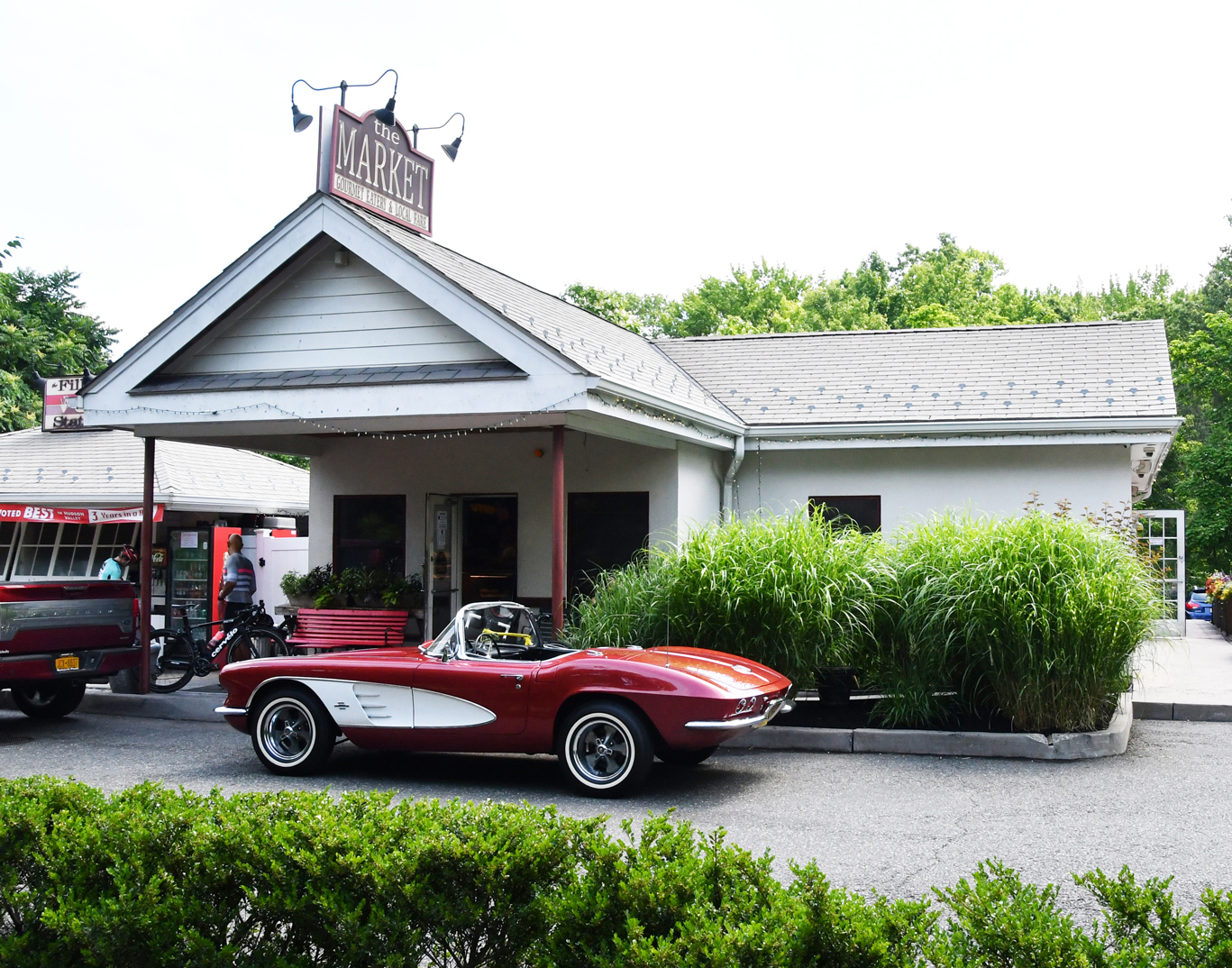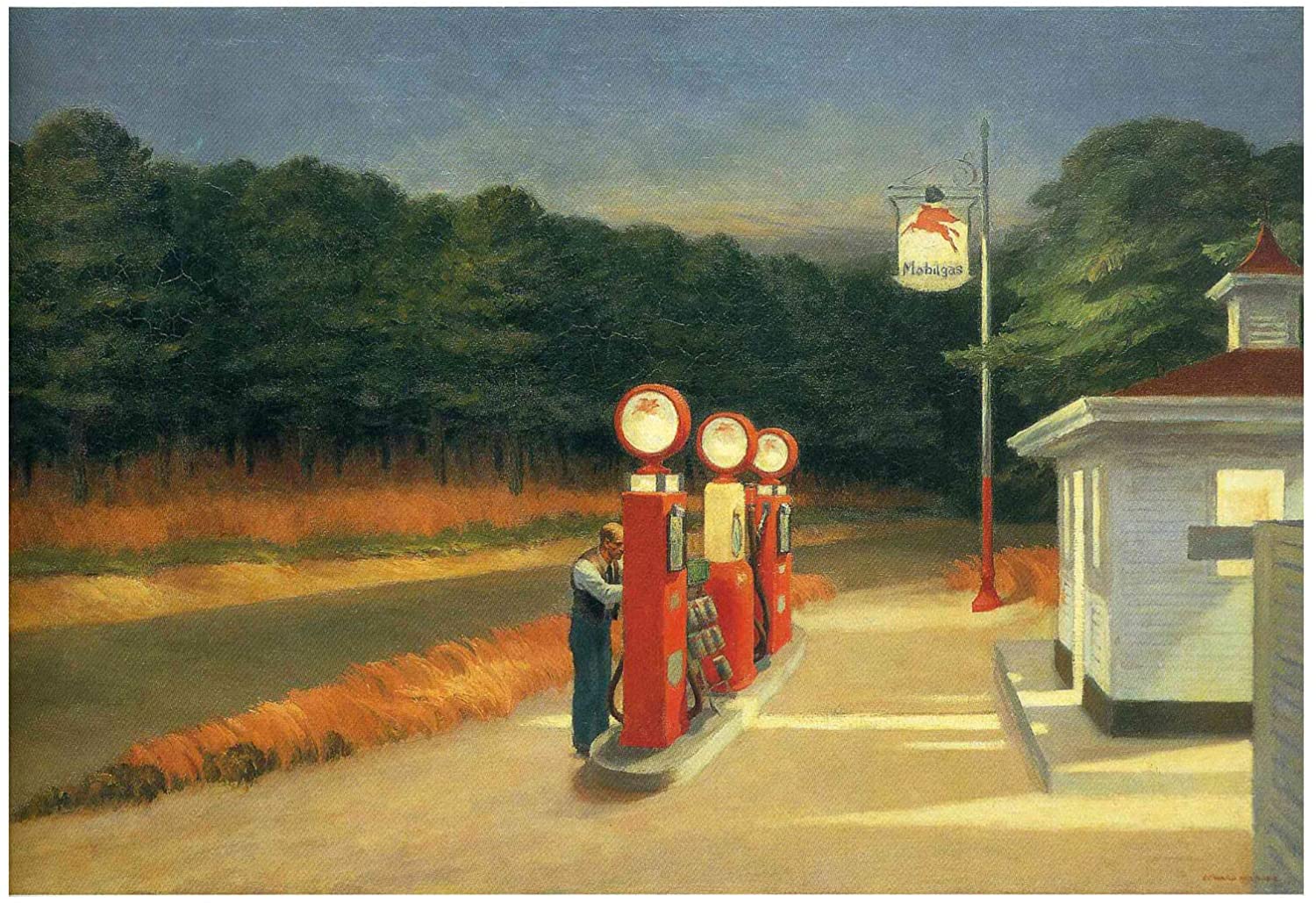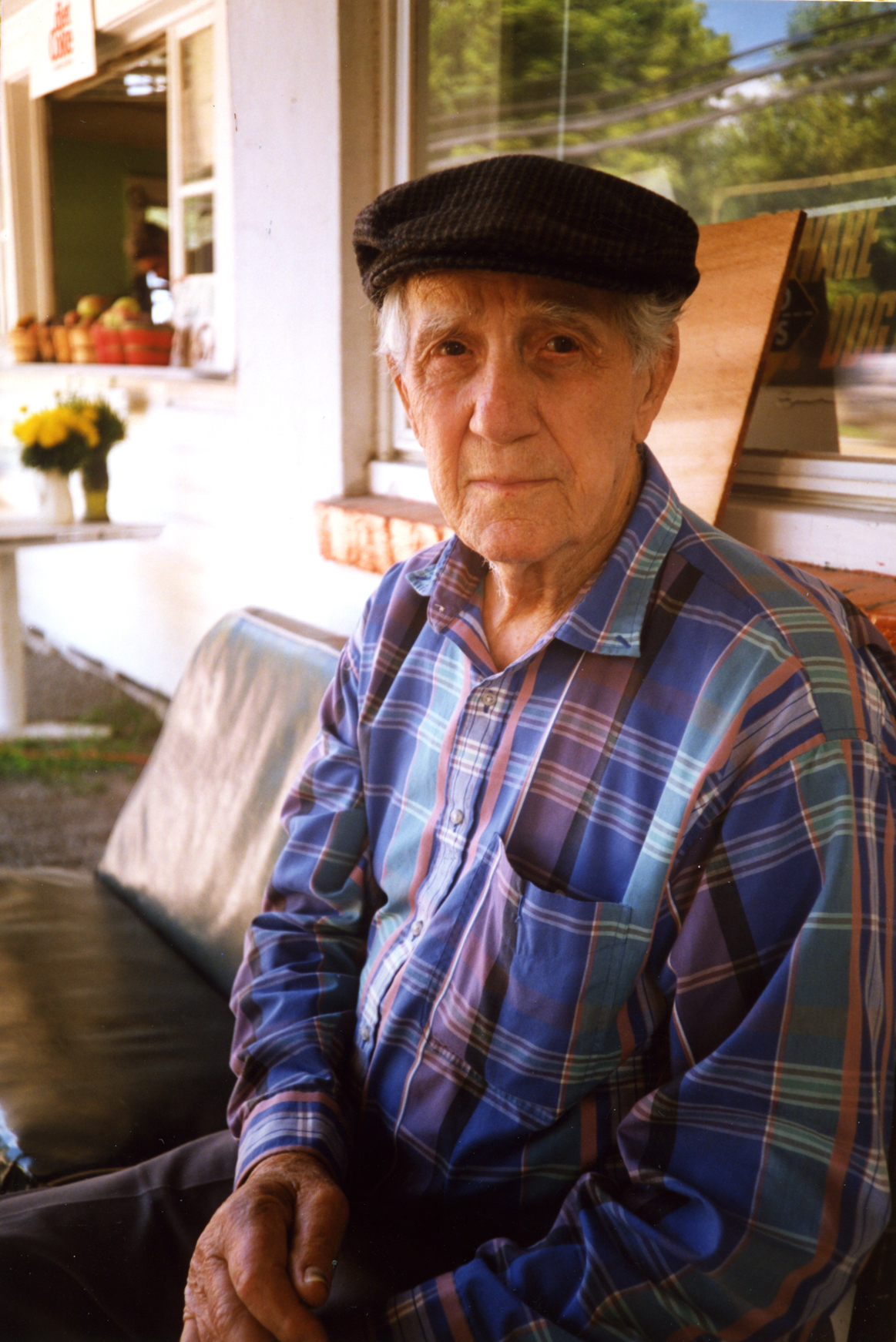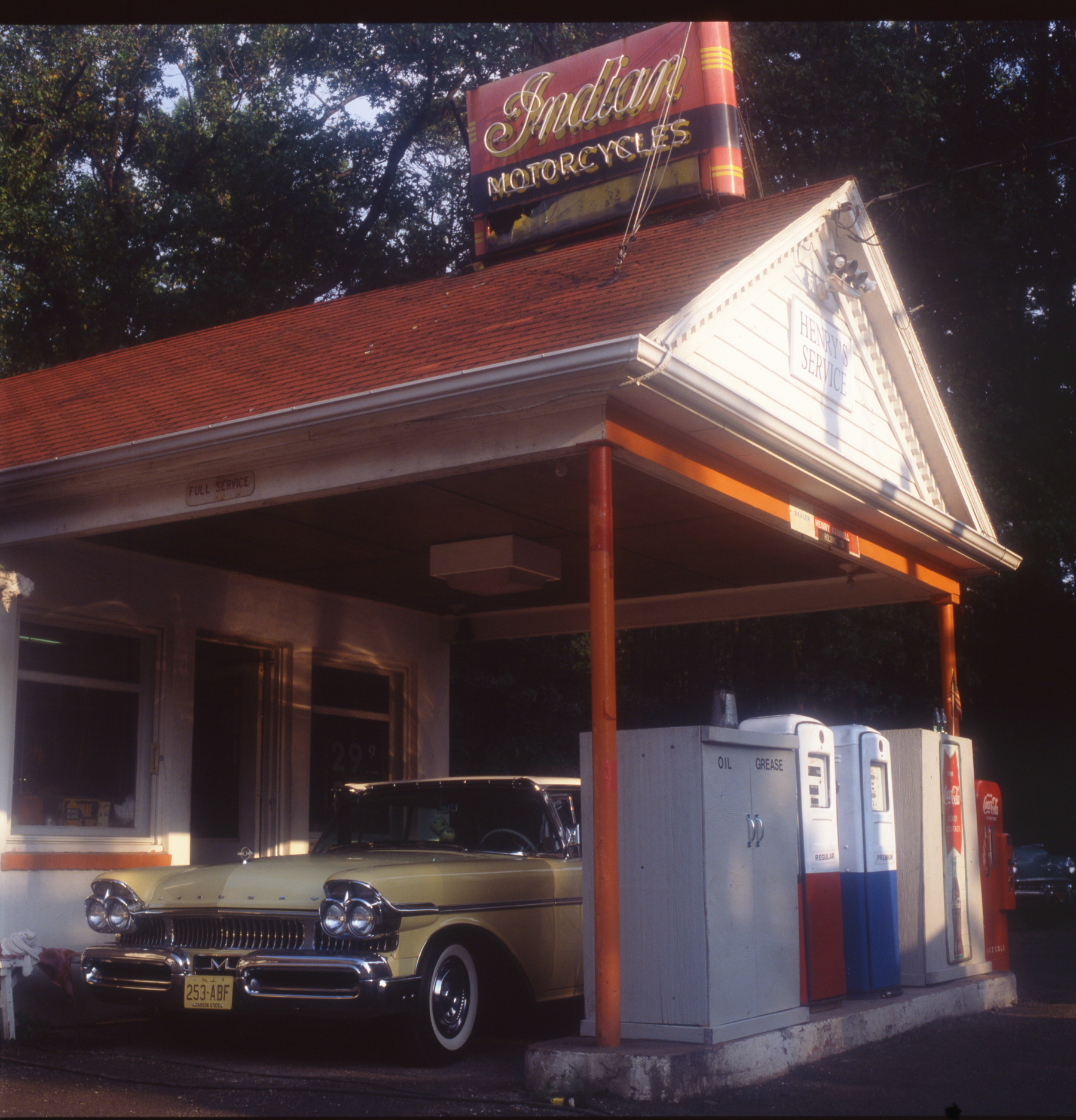As cultural icons, certain local roadside features past and present possess a mythic life of their own. Over the course of our lives they become universal reference points integrated into our personal story.
The “Evil Clown” of Middletown, NJ and the Red Apple Rest in Tuxedo, NY are two. Without doubt, high on that list resides the Indian Motorcycle sign of Palisades, NY.
Mystery of the vanishing
Indian Motorcycle sign

Hugging Route 9W North on the New Jersey side of the Hudson, the 9W Market offers a  gourmet food oasis that has become a magnet for bicyclists from all over the Tri-state area. It is doubtful that anyone enjoying their pan fried organic egg sandwich has a clue about the structure’s first life and its starring role in one of the boldest automobilia thefts in local history.
gourmet food oasis that has become a magnet for bicyclists from all over the Tri-state area. It is doubtful that anyone enjoying their pan fried organic egg sandwich has a clue about the structure’s first life and its starring role in one of the boldest automobilia thefts in local history.
Even from my early boyhood viewpoint in the back seat of my family’s 1948 Chevy Fleetline Aerosedan, our Sunday drives north on Route 9W never failed to entertain. Craning my neck like a hungry hatchling to peer out the small teardrop rear window, I loved the old roadhouse bars that seemed to defy gravity as they clung to the steep face of the great Palisades. For me though, I derived special delight from the old homey gas stations as they appeared through my back seat porthole.
Of all the wonders of roadside Americana that my family Sunday drives afforded, none gave me greater joy than a weathered white Gulf station with a snack bar. Like the little engine that could, it stood proud and alone in its diminutive glory each time we motored by, and we always motored by because my father only used Sunoco gas. 
Years later I learned that the little Gulf station enjoyed another admirer in the person of iconic American artist Edward Hopper. Born and raised in nearby Nyack, New York, Hopper is said to have drawn inspiration from the little station for his iconic 1940 work “Gas”.
The little Gulf station began life in 1939, when a towering rawboned motorcycle enthusiast named Henry Kennell built it as a sales point for Indian Motorcycles.
Time passed in decades. The world around Henry’s Gulf morphed into the frenetic Tri-state area. However, Henry’s Gulf remained a constant and his section of 9W seemed content to linger in 1939. One part of Henry’s Gulf though, while remaining unchanged, did steadily grow as an object of desire. Firmly affixed to the ridge of Henry’s station sat perched the crown jewel of Henry’s Gulf. There reigned the king of all signs, a roughly five foot by three foot glorious two-sided neon masterpiece that in 1939 proclaimed that beneath it could be found a genuine Indian Motorcycle dealership.

I met Henry in 1989 when I negotiated with him to film a Volvo Finance commercial set in 1961 at his, then, still active Gulf station.
Henry Kennel in spite of his 92 years maintained a gentle giant countenance. Warmly greeting you by extending a massive hand, the firm handshake seemed to extend past your hand and carry up to your elbow. His kind and affable manner like his Gulf station made you feel welcome.
From time to time during filming of the commercial Henry would saunter over from his house across Route 9W. During the breaks he would respond to my urgings to share some history of his station. He knew his Indian sign was special and he loved it.
Henry’s sign constantly generated inquiries.

Interest would often come from members of a motorcycle group called “The Sons of Danger.” A gregarious and fun loving collection of serious motorcycle enthusiasts, “The Sons of Danger” originated in the 1970’s as a creation of two pillars of the automobile advertising community. Its membership included executives of numerous automobile companies, journalists, and drivers. Names like Dan Gurney, Brock Yates and Paul Newman populated its roster.
Since the North American headquarters of Volvo resided barely a few miles away, “Sons of Danger” members including one of the two founders were keenly aware of Henry’s glorious sign. Many offers were made. Henry would not budge. Years turned to decades all the while the great Indian sign proudly anchored the present to the past from its position on high.

In 1991 Henry Kennell passed away. In a fitting continuation of ownership by kindred spirits, Henry’s Gulf station would be purchased by a legendary local vintage car owner and supplier of vehicles to the film industry, Jerry McSpirit. Owner of Cars of Yesterday Sales and Rentals, McSpirit’s involvement in supplying vintage vehicles to the film industry dates back to 1970. He provided a vehicle for my film shoot in 1989.
During McSpirit’s ownership much stayed the same. Certainly the Indian sign maintained its exalted and coveted status.
“An ill wind blows no good” goes the  adage. For Jerry McSpirit Tropical Storm Floyd in 1999 fits the bill.
adage. For Jerry McSpirit Tropical Storm Floyd in 1999 fits the bill.
Beginning as a Category 4 hurricane in the Bahamas, Floyd was a tropical storm by the time it reached northern New Jersey. The tropical storm packed punishing torrents of rain. September 16th 1999 witnessed record flooding and Dams bursting across New Jersey. It also marked the last time Henry Kennell’s Indian Motorcycle sign was ever seen.
When McSpirit went to assess the storms impact on his little station, the only damage to be seen was where the Indian Motorcycle sign had been carefully removed. During one of the worst storms in New Jersey history and after 60 years in place, Henry Kennell’s treasured Indian sign disappeared.
Jerry McSpirit sold the little Gulf station shortly thereafter.
Despite the offer of a generous reward, the last 21 years has not produced one word as to the fate of Henry Kennell’s Indian Motorcycle sign.

I grew up in North Jersey and although I don’t remember that particular station I’m sure we drove past it many times. Could the hurricane have blown it off and just maybe it’s in the Hudson River?
With all the biking you did I am sure you past it. There was no trace and it is a big and flat paved area around the station. If it got blown off, it got blown directly into the bed of someone’s pickup truck:)
I claim the reward.
A great story Burton!
For those of you who have not been by this place it is up on route 9W on the Northbound side before you get as far North as Piermont. It is still open and functioning and serves very nice sandwiches, etc. And it looks essentially as it did in the 30s and is easily recognizable. Of course, the Indian Motorcycle sign is missing…..but if you are younger and not from around here, you wouldn’t know that!
It is worth a trip and if you want to continue pursuing great old places that have earned their way into art history…..you can continue down into the Village of Piermont….where Woody Allen shot “The Purple Rose of Cairo”. And then drive further North into Nyack, where you can see the Edward Hopper Museum! It is a very scenic drive. And now that we are permitted to eat outside at restaurants, there are plenty of interesting places to eat along the roads in those areas.
Thank you Burton, and hope lots of folks use this as motivation to visit this interesting area!
It is certainly a great ride and thanks for calling attention to Piermont and the Edward Hopper Museum.
What great but sad story!!! Bet it show up one day!! Gynn
I’ve always had a special feeling for the place.
I moved from Brooklyn to Rockland County in 1978 and would pass by Mr. Kennell’s Gulf Station everyday commuting to NYC. In 1982 I moved to Palisades, NY and have lived here ever since. For years, I would purchase gas from Mr. Kennell, instead of driving a few miles into NJ to purchase cheaper gas just to get to know Mr. Kennell with the hopes of someday owning the Indian Motorcycle sign. I made a number of offers to purchase the sign along with many others, Mr. Kennell always said “no no it’s not for sale”.
The following is my understanding of happened to the sign. Sometime in the mid to late 1980s, Mr. Kennell shut down the gas station and rented the property to Mr. Jerry McSpirit. Mr. McSpirit used the property to store vehicles he rented out to the movie business. At about this time, an art deco museum from San Francisco offered Mr. Kennell $3,000 for the non-working neon sign, in addition to repairing the roof. Mr. McSpirit loved the sign and was not happy that it was sold and removed from the property. Shortly thereafter, Mr. McSpirit decided to reproduce the sign with new neon, which after so many years was now illuminated. Unfortunately, sometime in the late 1990s the reproduction sign was stolen.
You have the story pretty much dead on. I’m not sure if the final disappearance was because of theft or storm damage.
A minor correction
I am the current owner of the old gas station and have read many articles noting the gas station opening in 1939. I have a full-page article from the Sunday Journal News from March 1976 with a great interview with Henry Kennel where he is quoted opening the Gas station in 1929 and not 1939.
Hello Stavro. We have met. I have the old photography. The earlier owner after Mr. Kennel had given me information that conflicted with my recollections from my conversations with Mr. Kennel. I had remembered 1929 as well as other facts. When that owner disagreed I deferred. I was wrong to do that. My information and yours are correct. Thank you for your comments.
Great story and remember station well. Was it there after the movie w Drew Barrymore was shot?
I do know of a place in Bradley Corporate Park shopping/business ‘mall’ / it is filled w antique automobiles, signs and artifacts. – perhaps the owner of this shops has seen the sign…
Thank you for the comments and the remembrance. Collection in Bradley Corporate Park is gone. Possibly relocated or sold.
I remember driving 9W in my 1979 Porsche 928 in the 90’s and coming across this sign sitting on what looked to be an abandoned gas station. As a collector, I couldn’t believe my eyes. I looked for a phone number and found one handwritten on a piece of paper taped to the door. I called the number and spoke to a man, presumably Jerry McSpirit, and I asked if he would be willing to sell the sign. He answered yes! I thought I had hit the jackpot. But when I asked how much, he said $5000. Since I had recently purchased my beautiful 928 for $9000, I thought that $5000 for a sign was ridiculous so I passed. This is one of those “the one that got away” stories. Somehow this sigh popped into my head today so I Googled it and found this thread. What an amazing piece of history and Americana. I’m sorry I didn’t recognize it’s value at the time and to hear that it was stolen and has never surfaced.
Great memories indeed. Thank you for sharing.